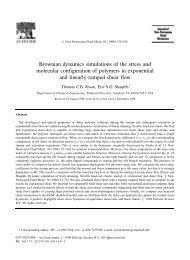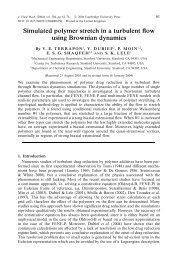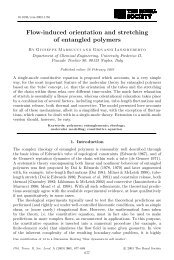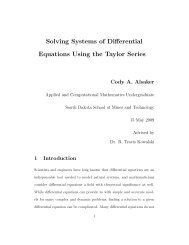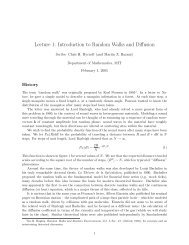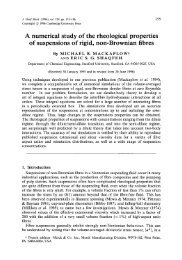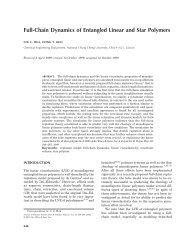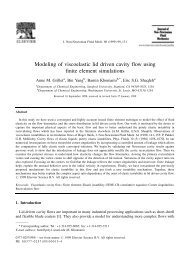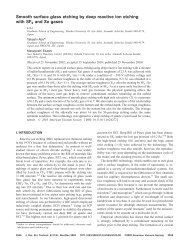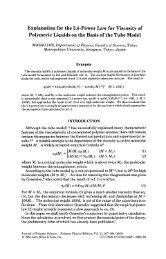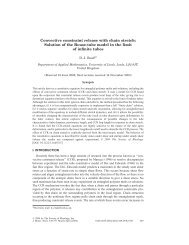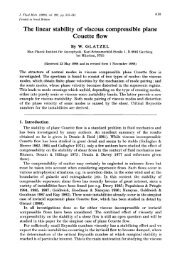Molecular modelling of entangled polymer fluids under flow The ...
Molecular modelling of entangled polymer fluids under flow The ...
Molecular modelling of entangled polymer fluids under flow The ...
Create successful ePaper yourself
Turn your PDF publications into a flip-book with our unique Google optimized e-Paper software.
42 CHAPTER 2. INTRODUCTION TO MOLECULAR RHEOLOGY<br />
section 2.4) since, again, the influence <strong>of</strong> CCR will be most prevalent in steady state <strong>of</strong><br />
shear where the linear viscous modes dominate the multi-mode stress predictions. In<br />
this way it is possible that the broad distribution <strong>of</strong> relaxation times typical <strong>of</strong> polydisperse<br />
branched melts allows effective stress predictions to be made without a complete<br />
knowledge <strong>of</strong> the dynamics <strong>of</strong> the whole molecule at all times. However, it should be<br />
noted that this effect is dependent on the material having an appropriate molecular<br />
weight distribution and will not hold in general.<br />
In addition, the non-linear spectrum should not be regarded as denoting absolute<br />
values characterising the details <strong>of</strong> the molecule. This parameters are certainly related<br />
to the true molecular values and do provide some useful information about the general<br />
molecular structure. However, the approximations used in the multimode method sever<br />
the quantitative link between the parameters and the molecule. Read and McLeish<br />
(2001) have made some progress towards generating the non-linear parameters from a<br />
knowledge <strong>of</strong> the reaction kinematics rather than by fitting. A significant theoretical<br />
break through will be required to make this approach quantitative for non-linear <strong>flow</strong>s<br />
with no parameter fitting.<br />
Rubio and Wagner (2000) have analysed the accuracy <strong>of</strong> the differential approximation<br />
for a range <strong>of</strong> simple <strong>flow</strong>s. <strong>The</strong>y identified a number <strong>of</strong> quantitative differences<br />
between the differential and integral versions <strong>of</strong> the model. Specifically the the differential<br />
approximation predicts much stronger alignment in shear than the full integral<br />
version. <strong>The</strong>y claim that, if used for the multimode model, the integral version would<br />
overpredict the steady shear viscosity <strong>of</strong> LDPE relative to experimental data. This may<br />
be another example <strong>of</strong> a cruder mathematically solution <strong>of</strong> a model producing closer<br />
agreement with experimental data.<br />
Appendix 2.I<br />
<strong>The</strong> Ito-Stratonovich relation<br />
Consider a coupled system <strong>of</strong> variables X i that obey the following general form <strong>of</strong><br />
stochastic equation<br />
dX p<br />
dt<br />
= F p (X i ) + g p (t), (2.44)<br />
where F p (X i ) is a set <strong>of</strong> functions <strong>of</strong> all <strong>of</strong> the X i which couples the dynamics <strong>of</strong> the<br />
X i . <strong>The</strong> stochastic noise term, g p (t) has the following average moments<br />
〈g p (t)〉 = 0<br />
〈<br />
gp (t)g q (t ′ ) 〉 = Γδ(t − t ′ )δ pq .<br />
(2.45)<br />
where Γ is a constant with respect to time which may be different for each p. Thus<br />
each variable in the system is controlled by an independent stochastic force whose



